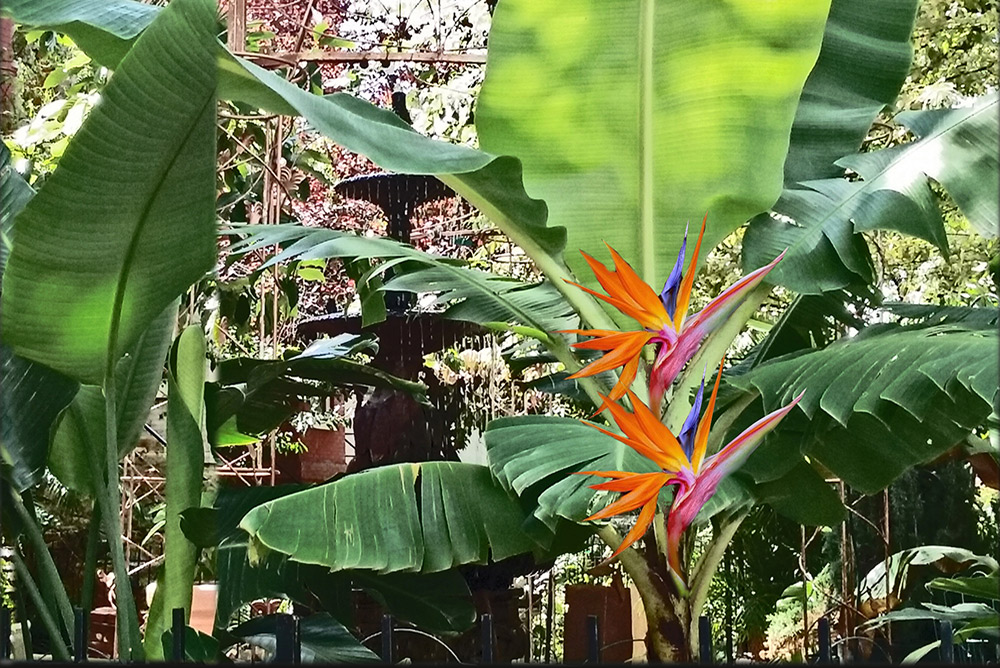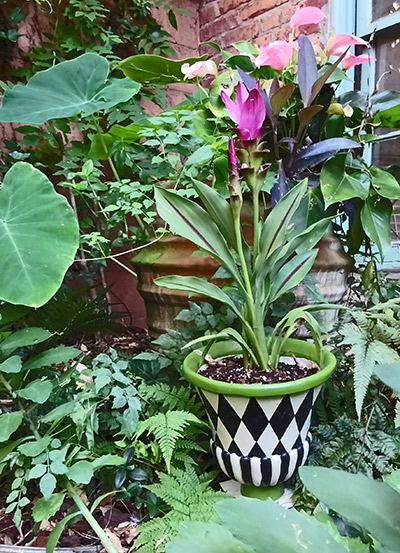
Thanks to the wonders of Photoshop, a banana plant outside the Surroundings nursery on Capitol Hill masquerades as a Bird of Paradise. / Photo, here and on the front, by Stephanie Cavanaugh.
MY BABY, a fine piece of work, and her Personal Prince Pete share a newly built and bought home in Raleigh, North Carolina, with Tallula, a large brown dog, part Lab and part Plott Hound, who’s an excellent mouser and does several tricks, if bribed.
They landed here because Pete, a man of liberal leanings who resembles a younger Brad Pitt, joined the National Guard to fly Apache helicopters, as one does, and Raleigh is one of a handful of bases in this country that raises or musters or whatever one does with them, and it seemed the best option. This is so nuts I can’t tell you, but that is neither here nor there, because thankfully he’s now done. Exhale.
This more or less accidental and initially temporary location appears to have become rather suddenly and dramatically permanent as they, with the abetment of the lovely mother-in-law, managed to snag in a single week investment properties consisting of two vacant lots and a shack of a house, notable for its decrepitude and location across from a cemetery—a location even the real estate agent said had its downside. On the upside, all are in walking distance of downtown. On the other downside, there’s not a great deal to be said yet for Raleigh’s downtown, though it’s on the verge of becoming the next Austin, they say.
While there’s a budding foodie and craft beer scene, the general area is primarily a hotbed of fried foods. The 1853 Grille at the Raleigh Flea Market, which sadly just closed, served fried Twinkies, fried HoHos, bloom ‘n fried onions, funnel cakes, fried candy bars and (as opposed to simply fried) DEEP-fried pecan pie. Breakfast at a downtown café was, on one recent visit, fried chicken topped with fried eggs with fried churros on the side. I know just what you’re thinking: It is indeed amazing that there are some very old people here.
Anyway. Baby and her Prince are now budding land barons, up to their eyeballs in real estate, among their various other doings.
This is all beside the point, which is the introduction to my most spectacularly wrong-headed garden addition yet. My newest example No. 1 of why you should always read something about the plants you covet before you collide with the possibility of a spontaneous purchase.
It all began idyllically. The Prince and I visited Raleigh last weekend and took Baby on our usual side excursion to the State Farmers Market, half of which is devoted to tomatoes, okra and edibles of that ilk, and half to some of the most enticing tropical plants I have ever seen grouped in one location, and it’s generally inexpensive bordering on cheap, at least to our city eyes. There are lemons and limes, gardenias and jasmine, hibiscus and camellias. Some are the size of trees, some budlings; the scent is so heady you could expire with ecstasy; the colors are glorious, hypnotic in their strangeness. Did you ever see the film Mothra? Probably not, since it was the second half of a double feature in 1961, I think. But believe me, it’s just like that psychedelic paradise garden, where a giant moth is coaxed forth to protect these miniature singing island people… Come to think of it, a tropical horror story is what I’m about to tell, momentarily.

A Siam tulip in the corner of Gardener Cavanaugh’s Capitol Hill garden. / Photo by Stephanie Cavanaugh.
Among our finds, a huge orange canna that will vibrate splendidly against their house, which is painted a shade called Carolina Blue, a shade god probably had in mind when he named the color. There was also a purple Siam tulip, which is not a tulip though the flower somewhat resembles one but a variety of ginger that is native to Siam, tall-growing, probably delicate, and possibly impossible for either of us to deal with. This, however, was not the mistake I am referring to; this was par for the course.
Now.
Of all the exotic plants I’ve coveted, the Bird of Paradise has proved most elusive. Growing like a weed in hot places where I don’t happen to live, and aptly named, its flower is like the head of an exotic bird. Most commonly that flower is green-beaked, orange-plumed, with a fripple* of purple sticking up for emphasis, and grows out of a three- to five-foot stand of split-leaf foliage. But what I found was even more exotic, a WHITE Bird of Paradise, or mostly, so as the flower is shot with the faintest tinge of purple at its base, or so I see from the tag, since it is not in bloom at the moment.
I never thought I wanted a white one; indeed I didn’t know they existed. But having read the tag, I felt palpitations; my chest still heaves at the thought.
We trotted everything back to the house, Baby doing a brilliant job of dividing the canna, getting five plants from one, and splitting the Siam tulip in two, so I would stop whining that I want one and should have bought one and so forth. Thanks to me, she’s way ahead of where I was at her age, plant-wise. I was 32 before I had more than a fire escape for a garden; she grew up with one.
The cannas were planted behind the blue and greenish white hydrangeas in front of their house, while the Bird sat in temporary splendor, lording it over an entire corner of the border for a few days before we loaded it into our truck (such a sexy trip vehicle, but you just never know, do you?) for transport home to Capitol Hill.
How splendid I thought, settling in to Google the growth habits and needs of the Strelitzia Nicolai, which sounds to me like a lethal Russian virus, and to Baby a Russian ballerina, succinctly capturing a key difference between our outlooks.
It seems your options for obtaining a specimen this far north are fairly limited. Other than schlepping one home from Florida or California, one can order on Amazon where a six-inch pot goes for $7.99 + $5.49 shipping (not eligible for Prime), though they’re all out of stock, grabbing this five-foot-tall plant was indeed a coup. I was delirious. And it was just $18. But if you’re thinking about running right off and ordering, figuring you’ll just wait patiently for delivery, heh heh, STOP.
Quoting from the South Florida Plant Guide follows, please provide your own horror music as you read—start it softly so it can build. The text begins benignly, indeed joyously to my ear, or eye I suppose you might say since I’m reading: “The unique white bird grows in a clumping form and needs a large area in which to spread out and unfurl its big leaves.”
Oooh . . . ahh! JUST what I’m looking for, now tell me about the flowers….
“The plant blossoms on and off during warm weather, with flowers that bear an astonishing resemblance to a bird’s head.” Yes, go on! “The blooms, however, are less important to your landscape than the ultra-tropical look created by the beautiful foliage. The leaves look like an elite version of a banana plant. A white Bird of Paradise can be a real showpiece in a landscape . . . “
A showpiece! I need a showpiece! I love showpieces! And an “elite version of the banana plant”? Consider the snob appeal of this! Everyone and their brother is growing banana plants; why, one is now struggling through its third summer in the front garden. The neighbors are going to plotz with envy.
That it’s tropical is not an issue, as I’m lucky enough to have a little greenhouse. I’ll stick it in a pot and this showpiece will be the crowning glory of my winter garden . . . but then they continue: “The mistake most people make with a white Bird—and many other South Florida landscape plants—is not planning ahead for growth.”
You might increase the volume of ominous music here.
“This is a big plant.”
Oh? A lot of envy?
“When mature, it’s going to be over twenty feet tall by at least six feet or more wide, and it can tower over a small one-story house.”
Go ahead and read that again, let it swill around in your brain for a moment.
Twenty feet tall, six feet wide, or more?
That statement is accompanied by a photo of a giant white Bird of Paradise waving cheerily above the peak of a two-story house and crowding the front door.
And I thought my minute garden was in for a smidge of trouble, shoehorning what I assumed was a four-foot plant into to my collection of invasive vines, and other things that climb and bush, never mind the kwanzan cherry tree, all screaming at one another in a space where one of anything would be plenty, particularly if you mix in a table and chairs. Oh, and a pond.
Of course, you ask, where was My Prince (Baby’s was at work) while all of this buying was going on? Lifting our various finds onto the truck, even paying for a thing or three. You know he’s an enabler, classic behavior this. An enabler, says Merriam-Webster is: “…one who enables another to persist in self-destructive behavior (as substance abuse) by providing excuses or by helping that individual avoid the consequences of such behavior.”
See? His fault, as always. Sigh.
Meanwhile, my little greenhouse, just 100 square feet and nine feet high, is totally inadequate. He can either build a bird house or drill a hole in our living-room ceiling so it can grow up and flower in a corner of our bedroom. I add these last thoughts only because Baby, who read this piece in advance, said, “Why are you always ending so abruptly. It’s as if you run out of things to say, and just stop.”
Yes.
—Stephanie Cavanaugh
* I am appalled to find that the Urban Dictionary defines fripple as a frozen nipple. “When you get wet or cold and your nipple goes hard.” I prefer to think it is what it sounds like; a fillip of color or texture that contrasts with and enhances whatever it’s attached to. I made this up myself.
Gardener Cavanaugh is working on a book about urban gardening. Her own city plot is on Capitol Hill in Washington, D.C. You can read all of her Green Acre columns by typing Green Acre in the search box at the top right of this page.

Good to know the white birds are BIG so I will not get one -although it was calling to me -lest get in trouble with the old HOA here is SoFLa
should have re-read. That’s here IN SoFla. BTW agreed on fripple def
You wouldn’t think it was nuts if I took you for a ride in one. 🙂
Great way to off the mother-in-law, princeling
Woops, make that BIG pot; darned teeny phone keys! Anyway, loved reading your book-to-be! 😉
Oh, yes, the monstrous WHITE Bird of Paradise! Here in Sarasota, FL they do grow very BIG. I’m even procrastinating ever putting my regular Bird Of Paradise into the ground–just keeping it in the bug pot where it has resided all summer…
Bug pot?
I read as well as you type. 🙂